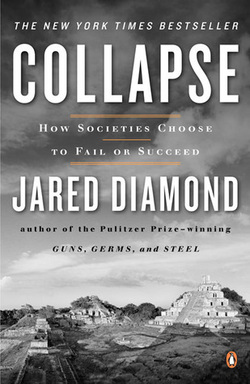
The analogy of how societies collapse and how communities collapse was unavoidable for me. If I were an environmental wonk, I would certainly give Jared Diamond's 2004 classic five stars for the weaving of history, science and great storytelling into a compelling read. But since I was expecting more than an ecological lens, I came away with a feeling of being slightly short-changed in trying to fully understand the subtitle: "how societies choose to fail or succeed."
Having said that, I must say that Diamond certainly gave us, as he calls it, a "road map" to better understand society/community collapse from varied perspectives. This is perhaps most topically done by his discussion midway through the book of the contrasting realities on the island of Hispanola between Haiti and the Dominican Republic. He demonstrates the sharp dichotomy between the two societies even before the recent earthquake, which has devastated Haiti. Positioning himself on the mountain ridge which forms part of the border between the two countries, he describes the view west into Haiti as one of denuded forests and barren landscape. By simply turning 180 degrees you can see the lush forest of the Dominican Republic. In answering the question -- How can two societies sharing the same island have such dramatically different outcomes? -- Jared Diamond gives glimpses of the applicability of his frame beyond the environmental.
One of the most compelling images Diamond summons for us is the thought of what would have gone through the mind of the native felling that last palm tree on Easter Island -- once a island rich in old growth palm and other forests and now a treeless wind-scape. Diamond moves us from the retrospective question: what was he thinking? to an excellent description of how this last act was not one of individual intention or ignorance but rather the last piece in a failure of group decision making.
These failures in group decision making rest broadly on either conflict of interest or group dynamics. For which the author describes three factors: (1) groups fail to anticipate a problem before it arises; (2) groups fail to perceive a problem that has already arisen, and, finally, (3) groups fail to even attempt to solve a problem even after it has been perceived. Though the author is nearly silent on many of the contemporary issues (beyond climate change) to which this framing would be instructive -- education, health care, terrorism, economics -- that doesn't prevent his readers from the application. And I think communities would be well served by doing just that.
Having said that, I must say that Diamond certainly gave us, as he calls it, a "road map" to better understand society/community collapse from varied perspectives. This is perhaps most topically done by his discussion midway through the book of the contrasting realities on the island of Hispanola between Haiti and the Dominican Republic. He demonstrates the sharp dichotomy between the two societies even before the recent earthquake, which has devastated Haiti. Positioning himself on the mountain ridge which forms part of the border between the two countries, he describes the view west into Haiti as one of denuded forests and barren landscape. By simply turning 180 degrees you can see the lush forest of the Dominican Republic. In answering the question -- How can two societies sharing the same island have such dramatically different outcomes? -- Jared Diamond gives glimpses of the applicability of his frame beyond the environmental.
One of the most compelling images Diamond summons for us is the thought of what would have gone through the mind of the native felling that last palm tree on Easter Island -- once a island rich in old growth palm and other forests and now a treeless wind-scape. Diamond moves us from the retrospective question: what was he thinking? to an excellent description of how this last act was not one of individual intention or ignorance but rather the last piece in a failure of group decision making.
These failures in group decision making rest broadly on either conflict of interest or group dynamics. For which the author describes three factors: (1) groups fail to anticipate a problem before it arises; (2) groups fail to perceive a problem that has already arisen, and, finally, (3) groups fail to even attempt to solve a problem even after it has been perceived. Though the author is nearly silent on many of the contemporary issues (beyond climate change) to which this framing would be instructive -- education, health care, terrorism, economics -- that doesn't prevent his readers from the application. And I think communities would be well served by doing just that.
To be tweeted links to my new posts -- blog, book reviews (both nonfiction and fiction), data or other recommended tools -- either go to Twitter.com and follow me @jcrubicon, or just go to my Home page and click on the Twitter button on the right, just above the tweet stream, and follow me @jcrubicon.
 RSS Feed
RSS Feed
